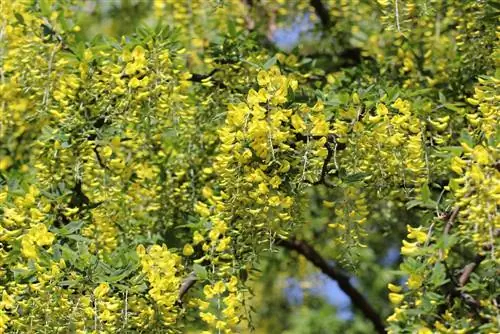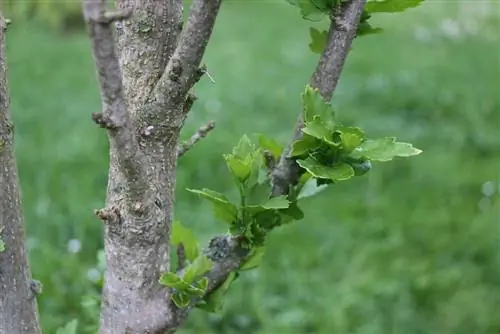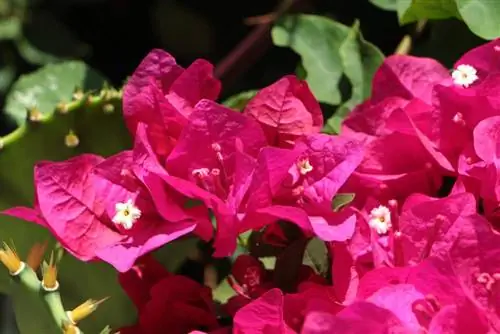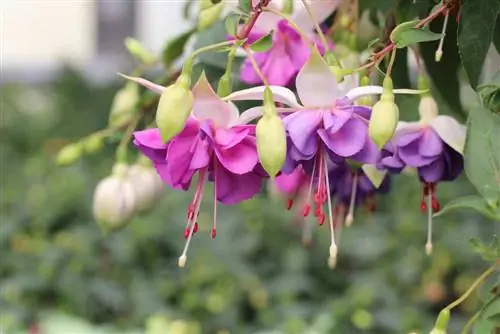- Author admin [email protected].
- Public 2023-12-17 03:39.
- Last modified 2025-06-01 06:48.
The laburnum (bot. Laburnum) originally comes from the southern Mediterranean, where the shrub or small tree still grows wild today. It owes its popularity in gardens and parks to its magnificent, namesake flower, because the bright golden yellow flower clusters hang down from the crown like lush curtains. Thanks to the different flowering times of different types of laburnum, the blooming splendor can be enjoyed for a long time.
Flowering time and duration of the different species
When and how long the laburnum blooms in the garden depends on the specific species. Basically, a distinction is made between two species and a hybrid of them. These look very similar on the outside, but do not bloom at the same time. Botanists differentiate between these species:
- Common laburnum (Laburnum anagyroides)
- Alpine laburnum (Laburnum alpinum) and
- Noble laburnum (Laburnum watereri 'Vossii')
The species known as noble laburnum is a hybrid of the first two wild species mentioned. Of the three laburnum varieties, it is the most common in parks and gardens because, in comparison, it blooms particularly magnificently and for a long time.
Noble laburnum (Laburnum watereri 'Vossii')
- Beginning of flowering: mid to late May
- Duration of flowering: end of May to mid-June
The flower clusters of the noble laburnum, which are up to 50 centimeters long and richly decorated with individual flowers, hang down from the tree like golden yellow drops. In contrast to the wild species, the flowers of the hybrid form have a very intense, sweet scent. This variety not only gives the gardener the most lush flowers, but also the longest-lasting ones: provided the weather is warm and dry, the flower clusters remain in their splendor for up to two weeks.
Alpine laburnum (Laburnum alpinum)
- Beginning of flowering: end of May to beginning of June
- Duration of flowering: mid to late June
The light yellow flower clusters of the Alpine laburnum, which are also up to 50 centimeters long, do not appear until quite late. Here, too, the duration of flowering depends heavily on the weather: if early summer is warm and dry, you can enjoy the splendor for up to two weeks. In rain and cool temperatures, however, the flowering period is very short.
Common laburnum (Laburnum anagyroides)
- Beginning of flowering: mid to late May
- Duration of flowering: end of May to mid-June
The common laburnum blooms about one to two weeks before the Alpine laburnum, but the flowering period is not as long-lasting as the hybrid form and is quite short, ranging from a few days to a maximum of a week. The flower clusters of the common laburnum, up to 25 centimeters long, are colored light to dark yellow.
Laburnum is highly poisonous
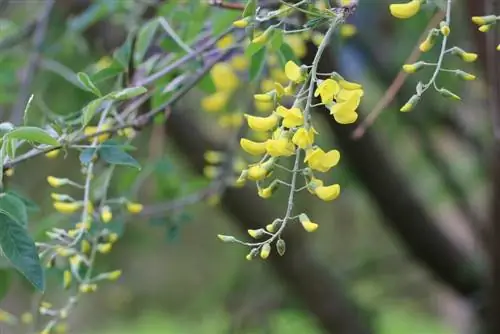
As beautiful as the laburnum blooms and as useful as its pollen-rich flowers are for insects, all parts of the plant and especially the seed-containing fruit heads are highly toxic and potentially fatal, especially for children. Therefore, if possible, only plant Laburnum where children are not allowed.
Caution, confusion
- The Indian Gold Rain -
The Indian laburnum, which is very similar to the laburnum species cultivated in this country, is rightly named because of its grape-like, golden-yellow flowers, but it is not another Laburnum species. Instead, the tubular cassia (bot. Cassia fistula) is a member of the carob family (bot. Caesalpinioideae) and is therefore only distantly related to the laburnums described here. The tree, which is widespread in India and Pakistan, is not hardy as a tropical plant here and can therefore only be cultivated in planters. Also in contrast to the Laburnum species, the fruits of the tubular cassia are edible. They are also known as “Manna”.
Lanburne doesn't bloom
- possible causes and their elimination -
Actually, all laburnum species are as undemanding as they are willing to bloom. Nevertheless, there are a few reasons that can lead to a lack of flowers.
Age of the plant
The most important reason for the lazy flowering is probably the age of the laburnum. Specimens grown from seeds in particular take around eight to ten years to bloom for the first time - so when buying new, you should pay attention to older plants grown from cuttings. These usually bloom for the first time after about three to five years.
In addition to very young ones, older laburnums often show a lack of flowering: from the age of around 15 years, the former abundance of flowers begins to decline significantly. Now the lifespan of the laburnum is gradually coming to an end, because all species generally do not live very long.
Inconvenient location
Like so many flowering plants, laburnum develops its most lush flowers in a sunny location. If, on the other hand, he is unwilling, it may be too shady for him. Furthermore, a soil with an acidic pH value below 6 orAn impermeable substrate that tends to become waterlogged will cause the flower to fail. The only thing that helps here is improving the soil and raising the pH value or moving the tree. An alkaline pH value between 6.5 and 8 is ideal for laburnum.
Damaged roots
Be especially careful not to damage the sensitive roots when planting the laburnum or during later soil work. Since they grow flat and close to the surface, you should avoid rough processing of the root slice. In addition to gardening, voles can also destroy the roots, which is also initially reflected in a lack of flowers. If the roots are already so damaged that the tree in question is already wobbling, it can no longer be saved. Otherwise, patience and an extra portion of fertilizer (e.g. mature compost) will help. Voles should be driven away.

